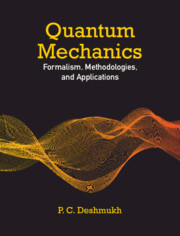Book contents
- Frontmatter
- Dedication
- Contents
- List of Figures
- Foreword
- Preface
- 1 Description of a Physical System
- 2 Path Integral Formulation of Quantum Mechanics
- 3 Probability Tangles and Eigenstates of One-dimensional Potentials
- 4 Angular Momentum
- 5 The Non-relativistic Hydrogen Atom
- 6 Approximation Methods
- 7 The Relativistic Hydrogen Atom
- 8 Quantum Mechanics of Spectral Transitions
- 9 The Many-Electron Atom
- 10 Quantum Collisions
- 11 Introduction to Quantum Information and Quantum Computing
- Appendix A Symmetry of the Hamiltonian
- Appendix B Schrödinger, Heisenberg, and Dirac “Pictures” of Quantum Dynamics
- Appendix C Spherical Harmonics
- Appendix D Occupation Number Formalism Second Quantization
- Appendix E Electron Structure Studies with Qubits
- Index
1 - Description of a Physical System
Published online by Cambridge University Press: 14 September 2023
- Frontmatter
- Dedication
- Contents
- List of Figures
- Foreword
- Preface
- 1 Description of a Physical System
- 2 Path Integral Formulation of Quantum Mechanics
- 3 Probability Tangles and Eigenstates of One-dimensional Potentials
- 4 Angular Momentum
- 5 The Non-relativistic Hydrogen Atom
- 6 Approximation Methods
- 7 The Relativistic Hydrogen Atom
- 8 Quantum Mechanics of Spectral Transitions
- 9 The Many-Electron Atom
- 10 Quantum Collisions
- 11 Introduction to Quantum Information and Quantum Computing
- Appendix A Symmetry of the Hamiltonian
- Appendix B Schrödinger, Heisenberg, and Dirac “Pictures” of Quantum Dynamics
- Appendix C Spherical Harmonics
- Appendix D Occupation Number Formalism Second Quantization
- Appendix E Electron Structure Studies with Qubits
- Index
Summary
The measure of greatness in a scientific idea is the extent to which it stimulates thought and opens up new lines of research.
—P. A. M. DiracFrom our day-to-day experience, we develop our notion of reality. However, our perception of physical properties, such as position and momentum, needs refinement to describe natural phenomena correctly. In this chapter we introduce fundamental principles of the quantum theory that does so with enduring cogency. The laws of nature that govern the functioning of the physical universe cannot be accounted for using classical physics of Newton, Lagrange, and Hamilton. Foundational principles and mathematical structure of quantum theory are introduced in this chapter.
1.1 Quantum versus Classical Physics Theories
In classical physics, the mechanical state of a system is represented by a point in the position– velocity phase space, or equivalently in the position–momentum phase space. The entire theoretical formalism of Newtonian–Lagrangian–Hamiltonian mechanics is based on this Galilean conjecture. The classical hypothesis seems appropriate in a large number of physical situations that concern our day-to-day experiences. With this ansatz, the temporal evolution of a system is described by the trajectory of the point in the phase space. The trajectory is obtained from the equation of motion that governs the time dependence of position and velocity, represented respectively by q and (or alternatively the time dependence of position and momentum, represented respectively by q and p). The alternative equations of motion – Newton’s, Lagrange’s, and Hamilton's – are equivalent. Their applicability must be reconciled with the upper limit on accuracy with which conjugate physical properties of an object, viz. position and momentum, are simultaneously measured. There is, however, an inverse relation between the accuracy of simultaneous measurement of these two properties. The more accurately you measure either, the less accurately can you measure the other. The act of measuring either of the conjugate properties requires an observation. Observations resulting in accurate measurements of conjugate variables are, however, not compatible with each other. Heisenberg's principle of uncertainty is the quantitative expression of this law of nature. It is expressed as a rigorous mathematical inequality that is neatly written in a compact form. Nonetheless, we refrain from advancing its mathematical expression too soon. It has no classical analogue. It cannot be written in any terms of what we are familiar with from classical mechanics.
- Type
- Chapter
- Information
- Quantum MechanicsFormalism, Methodologies, and Applications, pp. 1 - 51Publisher: Cambridge University PressPrint publication year: 2024



